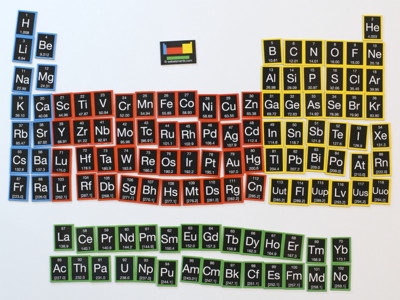Strontium: the essentialsStrontium does not occur as the free element. Strontium is softer than calcium and decomposes water more vigorously. Freshly cut strontium has a silvery appearance, but rapidly turns a yellowish colour with the formation of the oxide. The finely divided metal ignites spontaneously in air. Volatile strontium salts impart an excellent crimson colour to flames, and these salts are used in pyrotechnics.
The picture above shows the colour arising from adding strontium sulphate salt (SrSO4) to a burning mixture of potassium chlorate and sucrose. Do not attempt this reaction unless are a professionally qualified chemist and you have carried out a legally satisfactory hazard assessment. Strontium-90 (90Sr) has a half-life of 28 years. It is a product of nuclear fallout and presents a major health problem. Strontium titanate is an interesting optical material as it has an extremely high refractive index and an optical dispersion greater than that of diamond. It has been used as a gemstone, but it is very soft.
Strontium: historical informationAdair Crawford in 1790 recognized a new mineral (strontianite) in samples of witherite (a mineral consisting of barium carbonate, BaCO3) from Scotland. It was some time before it was recognised that strontianite contained a new element. Strontianite is now known to consists of strontium carbonate, SrCO3. The element itself was not isolated for a number of years after this when strontium metal was isolated by Davy by electrolysis of a mixture containing strontium chloride and mercuric oxide in 1808. Sometime prior to the autumn of 1803, the Englishman John Dalton was able to explain the results of some of his studies by assuming that matter is composed of atoms and that all samples of any given compound consist of the same combination of these atoms. Dalton also noted that in series of compounds, the ratios of the masses of the second element that combine with a given weight of the first element can be reduced to small whole numbers (the law of multiple proportions). This was further evidence for atoms. Dalton's theory of atoms was published by Thomas Thomson in the 3rd edition of his System of Chemistry in 1807 and in a paper about strontium oxalates published in the Philosophical Transactions. Dalton published these ideas himself in the following year in the New System of Chemical Philosophy. The symbol used by Dalton for strontium is shown below. [See History of Chemistry, Sir Edward Thorpe, volume 1, Watts & Co, London, 1914.]
Strontium: physical properties
Strontium: orbital properties
IsolationIsolation: strontium metal is available commercially and there is no need to make it in the laboratory. Commercially it is made on small scale by the electrolysis of molten strontium chloride, SrCl2. cathode: Sr2+(l) + 2e- → Sr anode: Cl-(l) → 1/2Cl2 (g) + e- Strontium metal can also be islated from the reduction of strontium oxide, SrO, with aluminium. 6SrO + 2Al → 3Sr + Sr3Al2O6 WebElements ShopWebElements now has a WebElements shop at which you can buy periodic table posters, mugs, T-shirts, games, fridge magnets, molecular models, and more. |
|||||||||
|
|





 Melting point
Melting point Boiling point
Boiling point Density of solid
Density of solid Pauling electronegativity
Pauling electronegativity First ionisation energy
First ionisation energy Second ionisation energy
Second ionisation energy


